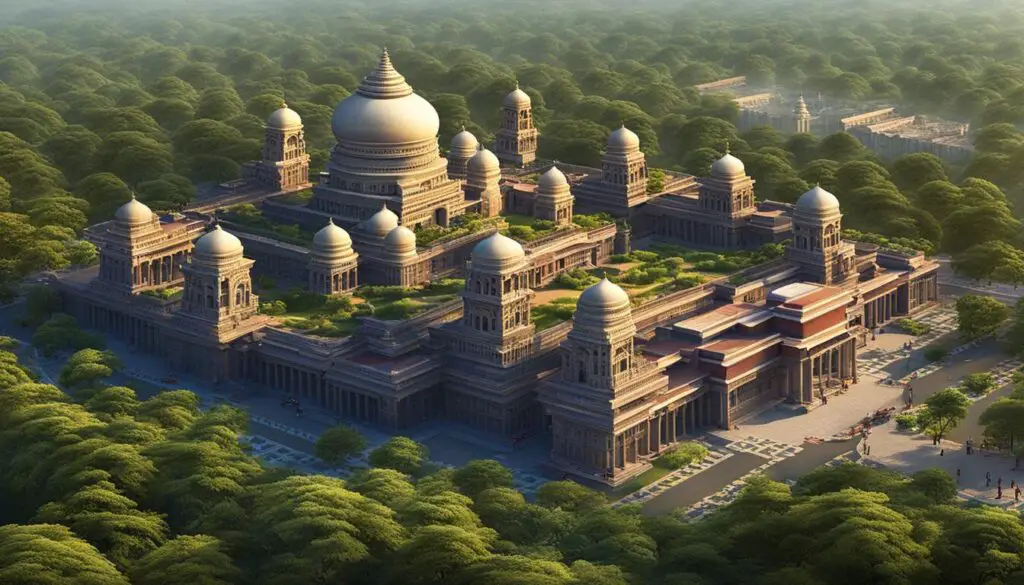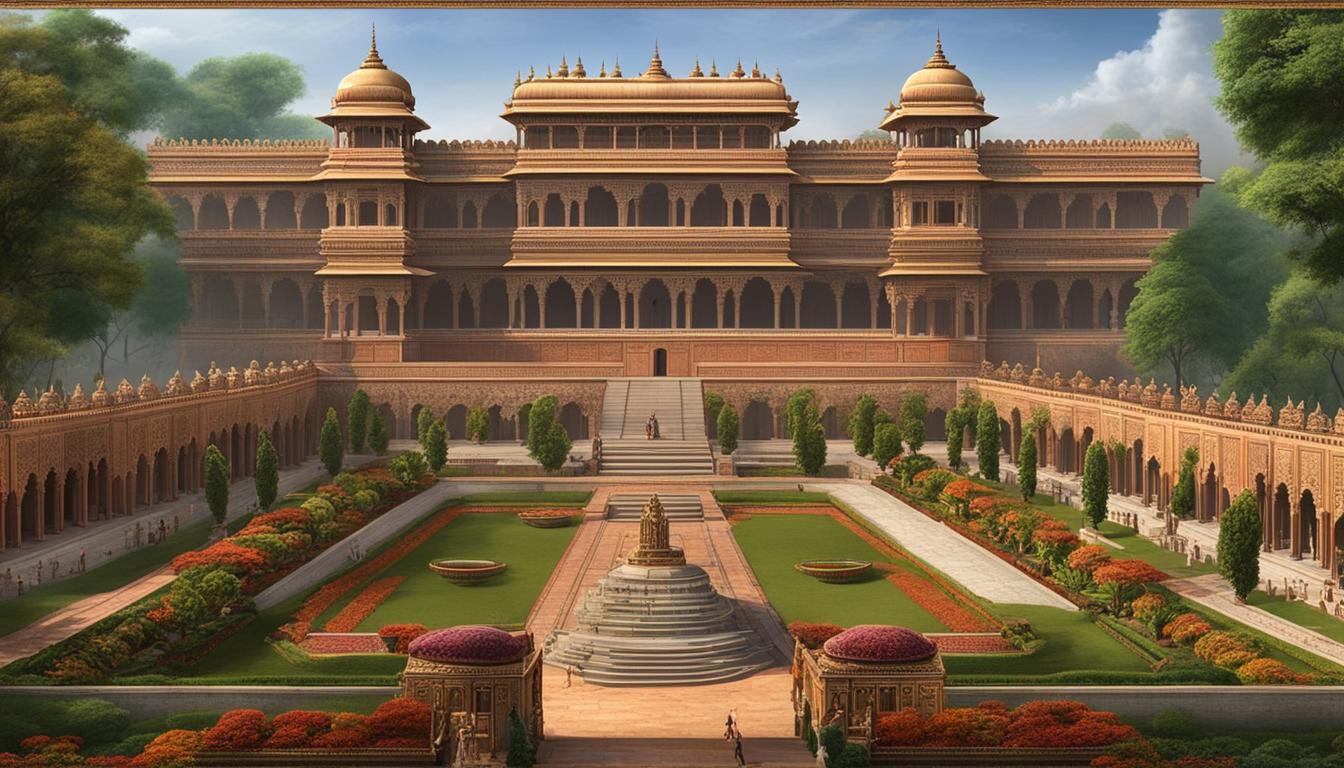Welcome to our exploration of the Mauryan Empire, a fascinating period of ancient India’s history that left a lasting legacy in terms of governance and administration. Led by influential figures such as Chandragupta Maurya and guided by the wisdom of Kautilya’s Arthashastra, the Mauryan Empire witnessed remarkable achievements and intricacies in its administrative structure.
The Mauryan Empire, spanning from 321 B.C.E. to 185 B.C.E., emerged as the first pan-Indian empire, with Chandragupta Maurya at its helm. This visionary leader laid the foundation by consolidating territories and overthrowing the Nanda power in Magadha. Working closely with Chandragupta, Kautilya, also known as Chanakya, played a pivotal role in shaping the empire’s governance through his treatise, the Arthashastra.
The Arthashastra delved into various aspects of leadership and government, highlighting the utilization of spies and deception as tools for effective governance. This emphasis on strategies and tactics contributed to the empire’s stability and growth during its peak.
Chandragupta’s successors, Bindusara and Ashoka, further built upon the Mauryan Empire’s legacy. While Bindusara played a significant role in maintaining the empire, it was Ashoka who truly left an indelible mark. Ashoka embraced Buddhism and promoted nonviolence and peace through his famous edicts, which became a hallmark of ancient India’s governance.
However, like all empires, the Mauryan Empire eventually faced decline. After Ashoka’s death, weakening rulers and internal division weakened the empire’s foundations. Additionally, Greek invasions posed significant challenges, preventing the Mauryans from reclaiming their authority. This era of Indian history concluded with the rise of the Shunga Dynasty in 185 B.C.E.
Key Takeaways:
- The Mauryan Empire was the first pan-Indian empire, lasting from 321 B.C.E. to 185 B.C.E.
- Chandragupta Maurya consolidated territories and overthrew the Nanda power in Magadha.
- Kautilya’s Arthashastra, a treatise on leadership and government, played a crucial role in shaping the empire’s administration.
- Ashoka’s edicts promoting nonviolence and peace became renowned.
- The empire eventually declined due to weakening rulers, internal division, and Greek invasions.
City Administration and Characteristics of the Mauryan Empire
In the Mauryan Empire, the city administration played a crucial role in maintaining order and providing essential services to the people. One key position in the city administration was that of Nagarka, who had various responsibilities ranging from delivering water to managing public infrastructure and handling crises like floods and diseases.
The Arthashastra, a treatise on leadership and government written by Kautilya (Chanakya), an influential figure during the Mauryan Empire, outlined the structure of the municipal government. According to the Arthashastra, the government consisted of six boards, each tasked with specific duties such as trade control and demographic censuses.
The Mauryan Empire strategically positioned five primary governmental centers across the empire to facilitate trade and ensure access to essential resources. These centers played a vital role in the administration and governance of the empire.
To maintain their supremacy, the Mauryan Empire relied heavily on a powerful military. Their military forces included elephants, cavalry, foot soldiers, and specialized units, making them formidable in both offense and defense.
Communication was essential for the smooth functioning and expansion of the Mauryan Empire. The empire established robust methods of communication, both through land and waterways, enabling effective administration and quick dissemination of orders and information.
The Mauryan Empire boasted a stable state administration, which was organized into provinces, districts, and village-level administrators. This hierarchical structure ensured efficient governance and the smooth implementation of policies throughout the empire.

Overall, the Mauryan Empire’s city administration and characteristics, as outlined in the Arthashastra, exemplified their efficient governance and military prowess. The strategic placement of governmental centers, the establishment of a strong military, and effective communication methods contributed to the empire’s success and longevity.
Decline and Conclusion
After the death of Ashoka, the Mauryan Empire experienced a decline in its power and influence. The last king of the Mauryan Empire, Brihadratha, met his unfortunate fate when he was assassinated by Pushyamitra Shunga. This event marked a significant turning point in the empire’s history, contributing to its eventual downfall.
Several factors played a role in the decline of the Mauryan Empire. Weakening rulers unable to maintain the empire’s unity and internal divisions within the ruling class gradually eroded its strength. Additionally, the Greek invasions dealt a severe blow to the Mauryans, further diminishing their authority and hindering their ability to regain control.
Despite its decline, the Mauryan Empire has left a lasting impact on India’s history. Spanning from 322 BCE to 180 BCE, the empire flourished under the rule of powerful leaders and had its capitals situated in prominent cities such as Pataliputra, Tosali, Ujjain, Taxila, Kalinga, and Suvarnagiri. Renowned for its strong monarchy, detailed city administration, and a formidable military, the Mauryan administration served as a testament to the empire’s grandeur.
FAQ
What is the Mauryan Empire?
The Mauryan Empire was the first pan-Indian empire that covered most of the Indian region from 321 B.C.E. to 185 B.C.E.
Who was the first leader of the Mauryan Empire?
Chandragupta Maurya was the first leader of the Mauryan Empire. He consolidated land and overthrew the Nanda power in Magadha, marking the start of the empire.
Who was Chandragupta Maurya’s chief minister and what was his contribution?
Chandragupta Maurya’s chief minister was Kautilya, also known as Chanakya. He advised Chandragupta and contributed to the empire’s legacy, particularly through the writing of the Arthashastra, a treatise on leadership and government.
What were the key principles of governance highlighted in the Arthashastra?
The Arthashastra emphasized the use of spies and deception in governance.
Which leaders played significant roles in maintaining and expanding the Mauryan Empire?
Bindusara and Ashoka, Chandragupta’s successors, played significant roles in maintaining and expanding the empire. Ashoka, in particular, became renowned for his edicts promoting nonviolence and peace.
What led to the decline of the Mauryan Empire?
The decline of the Mauryan Empire can be attributed to weakening rulers, internal division, and Greek invasions that further weakened their authority.
How long did the Mauryan Empire last and what were its primary governmental centers?
The Mauryan Empire lasted from 322 BCE to 180 BCE, with its capitals in Pataliputra, Tosali, Ujjain, Taxila, Kalinga, and Suvarnagiri.
What were some notable characteristics of the Mauryan Empire’s administration?
The Mauryan Empire had a strong monarchy, detailed city administration, and a powerful military. The city administration included the role of Nagarka, responsible for delivering water, maintaining public infrastructure, and handling crises like floods and diseases. The Arthashastra mentions a municipal government with six boards, each responsible for specific duties like trade control and demographic censuses.
